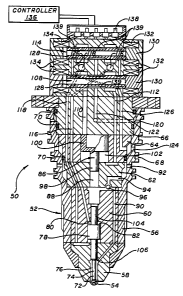Some of the information on this Web page has been provided by external sources. The Government of Canada is not responsible for the accuracy, reliability or currency of the information supplied by external sources. Users wishing to rely upon this information should consult directly with the source of the information. Content provided by external sources is not subject to official languages, privacy and accessibility requirements.
Any discrepancies in the text and image of the Claims and Abstract are due to differing posting times. Text of the Claims and Abstract are posted:
| (12) Patent: | (11) CA 2331163 |
|---|---|
| (54) English Title: | A HYDRAULICALLY DRIVEN SPRINGLESS FUEL INJECTOR |
| (54) French Title: | INJECTEUR HYDRAULIQUE SANS RESSORT |
| Status: | Deemed expired |
| (51) International Patent Classification (IPC): |
|
|---|---|
| (72) Inventors : |
|
| (73) Owners : |
|
| (71) Applicants : |
|
| (74) Agent: | RICHES, MCKENZIE & HERBERT LLP |
| (74) Associate agent: | |
| (45) Issued: | 2007-04-10 |
| (86) PCT Filing Date: | 1999-05-03 |
| (87) Open to Public Inspection: | 1999-11-11 |
| Examination requested: | 2004-04-19 |
| Availability of licence: | N/A |
| (25) Language of filing: | English |
| Patent Cooperation Treaty (PCT): | Yes |
|---|---|
| (86) PCT Filing Number: | PCT/US1999/009669 |
| (87) International Publication Number: | WO1999/057430 |
| (85) National Entry: | 2000-11-02 |
| (30) Application Priority Data: | ||||||
|---|---|---|---|---|---|---|
|
A fuel injector which has a check valve (72) that is
hydraulically controlled by a control fluid. A volume of fuel
is pressurized within a fuel chamber (88) of the injector by an
intensifier (86). The check valve (72) controls the flow of fuel
from the fuel chamber through at least one nozzle opening (54) of
a valve body. The flow of control fluid is controlled by a control
valve (108) which can move between a first position and a second
position. When the control valve is at its first position, the control
fluid creates an hydraulic force which moves the check valve (72)
to a closed position. When the control valve (108) is at its second
position, the control fluid moves the check valve (72) to an open
position to allow the pressurized fuel to be ejected or sprayed from
the nozzle opening(s). The intensifier (86) can also be hydraulically
controlled by a control valve (114).
L'invention concerne un injecteur de carburant qui comporte un clapet anti-retour (72) commandé hydrauliquement par un fluide de commande. Un volume de carburant est mis sous pression par un multiplicateur de pression (86) à l'intérieur d'une chambre à carburant (88) de l'injecteur. Le clapet anti-retour (72) commande l'écoulement du carburant depuis la chambre à carburant et son passage à travers au moins un orifice (54) de l'ajutage du corps de clapet. L'écoulement du fluide de commande est régulé par une soupape de contrôle (108) qui peut passer d'une première position à une seconde position et inversement. Quand la soupape de contrôle est dans sa première position, le fluide de commande génère une force hydraulique qui déplace le clapet anti-retour (72) de façon à l'amener en position fermée. Quand elle est dans sa seconde position, le fluide déplace le clapet anti-retour (72) de façon à l'amener en position ouverte et à permettre l'éjection ou la vaporisation du carburant sous pression par le ou les orifices de l'ajutage. Le multiplicateur de pression (86) peut aussi être commandé hydrauliquement par une soupape de contrôle (114).
Note: Claims are shown in the official language in which they were submitted.
Note: Descriptions are shown in the official language in which they were submitted.

For a clearer understanding of the status of the application/patent presented on this page, the site Disclaimer , as well as the definitions for Patent , Administrative Status , Maintenance Fee and Payment History should be consulted.
| Title | Date |
|---|---|
| Forecasted Issue Date | 2007-04-10 |
| (86) PCT Filing Date | 1999-05-03 |
| (87) PCT Publication Date | 1999-11-11 |
| (85) National Entry | 2000-11-02 |
| Examination Requested | 2004-04-19 |
| (45) Issued | 2007-04-10 |
| Deemed Expired | 2009-05-04 |
There is no abandonment history.
| Fee Type | Anniversary Year | Due Date | Amount Paid | Paid Date |
|---|---|---|---|---|
| Application Fee | $300.00 | 2000-11-02 | ||
| Maintenance Fee - Application - New Act | 2 | 2001-05-03 | $100.00 | 2000-11-02 |
| Maintenance Fee - Application - New Act | 3 | 2002-05-03 | $100.00 | 2002-04-05 |
| Maintenance Fee - Application - New Act | 4 | 2003-05-05 | $100.00 | 2003-04-16 |
| Request for Examination | $800.00 | 2004-04-19 | ||
| Maintenance Fee - Application - New Act | 5 | 2004-05-03 | $200.00 | 2004-04-19 |
| Maintenance Fee - Application - New Act | 6 | 2005-05-03 | $200.00 | 2005-03-24 |
| Maintenance Fee - Application - New Act | 7 | 2006-05-03 | $200.00 | 2006-04-04 |
| Final Fee | $300.00 | 2007-01-19 | ||
| Maintenance Fee - Patent - New Act | 8 | 2007-05-03 | $200.00 | 2007-04-12 |
Note: Records showing the ownership history in alphabetical order.
| Current Owners on Record |
|---|
| STURMAN, ODED E. |
| Past Owners on Record |
|---|
| None |